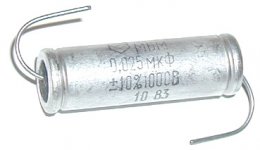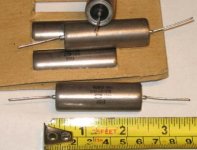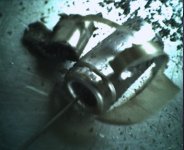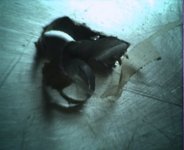I just bought some of those Russian paper/oil caps off of ebay. I haven't had a chance to try them out yet, but If anyne was wondering, I did give them the 'ol magnet test, and the leads and housing are non-magnetic. So that bodes well for their non-inductiveness.... uh, non-inductivity... um, non-inductivication...
Which Russian PIOs? The green version? The K40Y-9 body is solid steel and very magnetic, as are the crimps where the copper leads enter. Fortunately the external case is supposedly wrapped around a glass inner sleeve which isolates it from the cap internals. Curious which model you bought.
Gintas at KW Tubes in Lithuania. I don't think he has any posted right now, but he has been having server problems, so maybe he just took them all down for now. They were labeled as "aluminum bodied paper capacitors", I can't find any info on the particulars of the dielectric... I am assuming paper/alum foil, but I don't know about the oil part. The only designations on the box are OXO 462 149 TY, and then OTK-2-105 down at the bottom. I dunno, OXO is a mineral acid of some sort, so I guess that is the oil, unless X translates to something else in Russian. I'd pop one open, but I'm afraid that it might contain PCB's, so I don't want to rusk it.... I mean risk it... Freudian slip there
hope they 'sound' well...
like these...
http://www.triodedick.com/cleo_4/sprague_vitamin_q_punt33.jpg
the search goes on...
http://www.cs.joensuu.fi/~jkettune/Cats/WTF.jpg
like these...
http://www.triodedick.com/cleo_4/sprague_vitamin_q_punt33.jpg
the search goes on...
http://www.cs.joensuu.fi/~jkettune/Cats/WTF.jpg
adalin said:Isn't those just paper-caps? no oil?
Don't know. I can't find any info on just paper caps except metallised mylar paper surpressor caps.
somehow i felt that oil+paper would drip when disasembled
let me check...
http://www.cs.joensuu.fi/~jkettune/Cats/Shite.jpg
i cant tell
cap porn....
(click on pic)
http://www.ektypus.de/nos_kondensatoren.html
let me check...
http://www.cs.joensuu.fi/~jkettune/Cats/Shite.jpg
i cant tell
cap porn....
(click on pic)
http://www.ektypus.de/nos_kondensatoren.html
tomtt said:somehow i felt that oil+paper would drip when disasembled
That is where the line blurrs. as i understand it...TECHNICALLY, an electrolytic capacitor is paper in oil... aluminum plate material with a paper dielectric either impregnated or coated in electrolyte. They are called "dry" even though some of them contain moist material. Some caps are immersed in oil... like in olden days, and I dadre say that oil FILLED capacitors like motot runs would possible drip. But many paper and oil caps are made with kraft paper that has oil or wax mixed with the pulp before it is pressed, so I dunno how many HI-FI caps are that way, and how many are actually saturated afterward in "oil".
Ivan Mironenko said:Its just metallized paper capacitors. Nothing special, except they are very cheap
Gotcha... well that's actually cool, I can use them in the place of the mylar/paper Balck cats and black beauties that I have been using. The Cats had inductive leads anyway, but I just looked the other way on that because I liked they way they sounded.
As I understand it... and I am no expert... inductance can be boiled down to the capacity to store the magnetic field of a signal, so it has a reactance, like a capacitor does, but backward at a perticular frequency. So a copper clad steel lead will suffer from the 'ol skin effect, where the signal reacts to the different resistances of the two materials at different frequencies, resulting in reactance in the audio band... well into the audio band , sucking the low end, depending on the length and composition of the wire. The loweer the frequency, the less skin effect, so that is why the bass suffers in clad steel wire.
another consideration id parasitic oscillation that heppen outside the audio band. If the inductance is minimised, so is the ability of the lead to cause a ringing when it's Q is excited in conjunction with capacitance.
There is also apparently hysteresis losses in ferrous materials... energy wasted because of magnetic fields and whatnot, but I don't know anything about that stuff, I just nod to the experts
another consideration id parasitic oscillation that heppen outside the audio band. If the inductance is minimised, so is the ability of the lead to cause a ringing when it's Q is excited in conjunction with capacitance.
There is also apparently hysteresis losses in ferrous materials... energy wasted because of magnetic fields and whatnot, but I don't know anything about that stuff, I just nod to the experts
Hi,
If I were you I would worry more about possible polychlorinated biphenyl content in those caps than about ferromagnetic properties. PCB was used in my country up to the early 80's in capacitor manufacture and we had quite an affair because of the unadequate waste disposal by the factory.
I do not imply that those caps contain PCBs, but if they are NOS, that is possible.
Best regards,
Jaka Racman
If I were you I would worry more about possible polychlorinated biphenyl content in those caps than about ferromagnetic properties. PCB was used in my country up to the early 80's in capacitor manufacture and we had quite an affair because of the unadequate waste disposal by the factory.
I do not imply that those caps contain PCBs, but if they are NOS, that is possible.
Best regards,
Jaka Racman
- Status
- This old topic is closed. If you want to reopen this topic, contact a moderator using the "Report Post" button.
- Home
- Design & Build
- Parts
- Just bought some of those Russian paper/oil caps off of ebay



